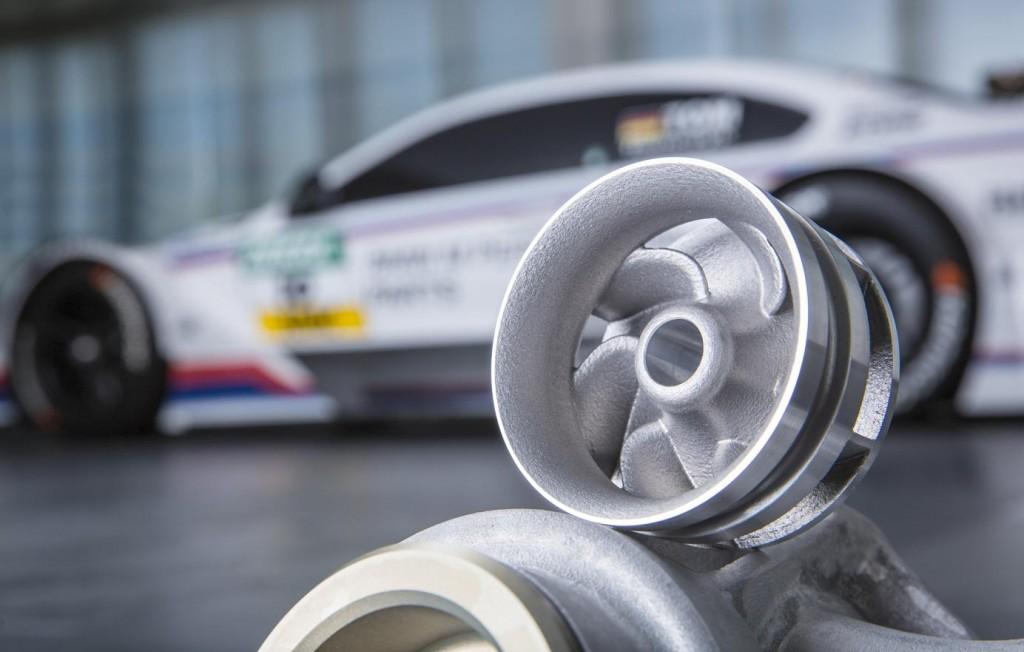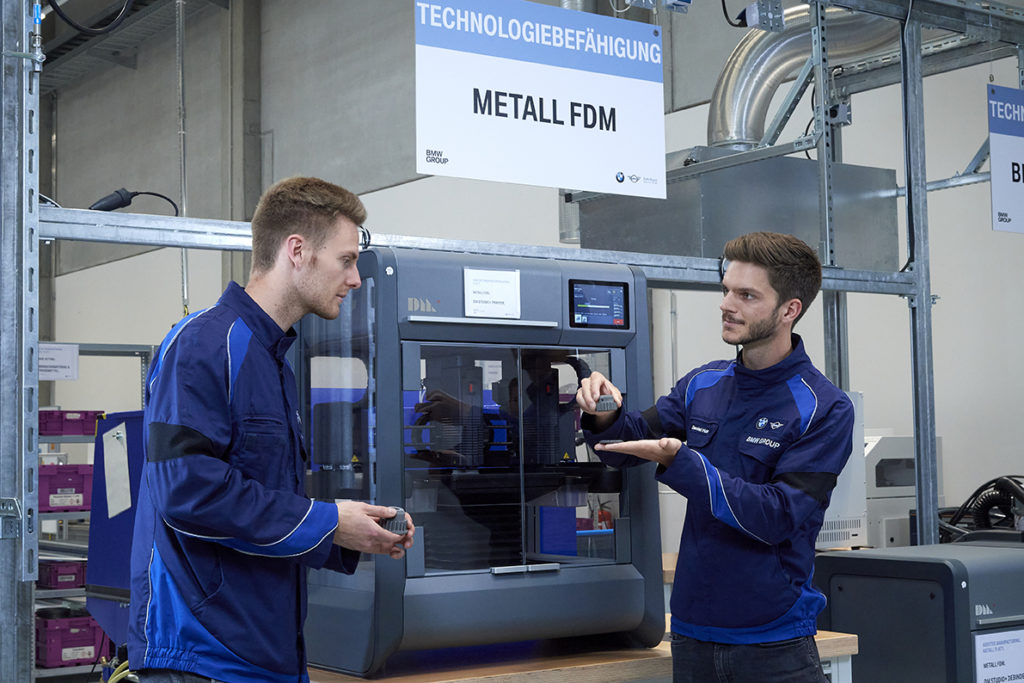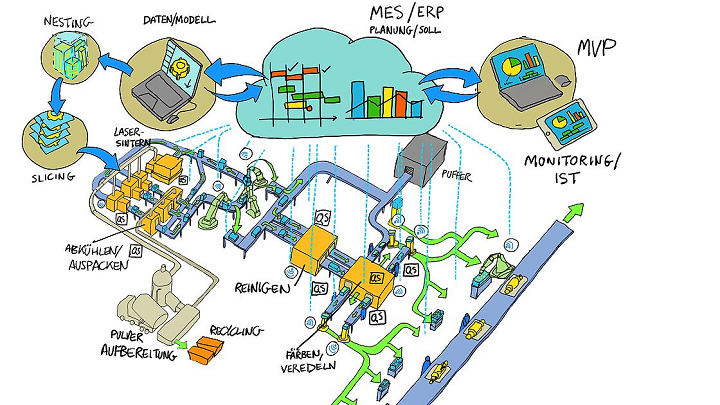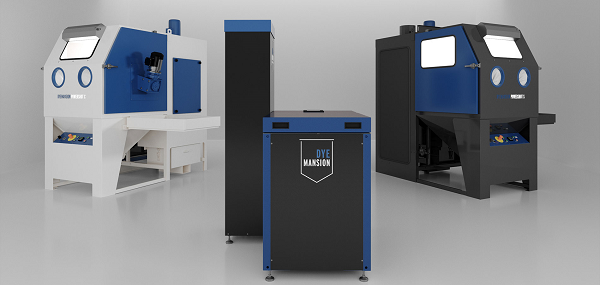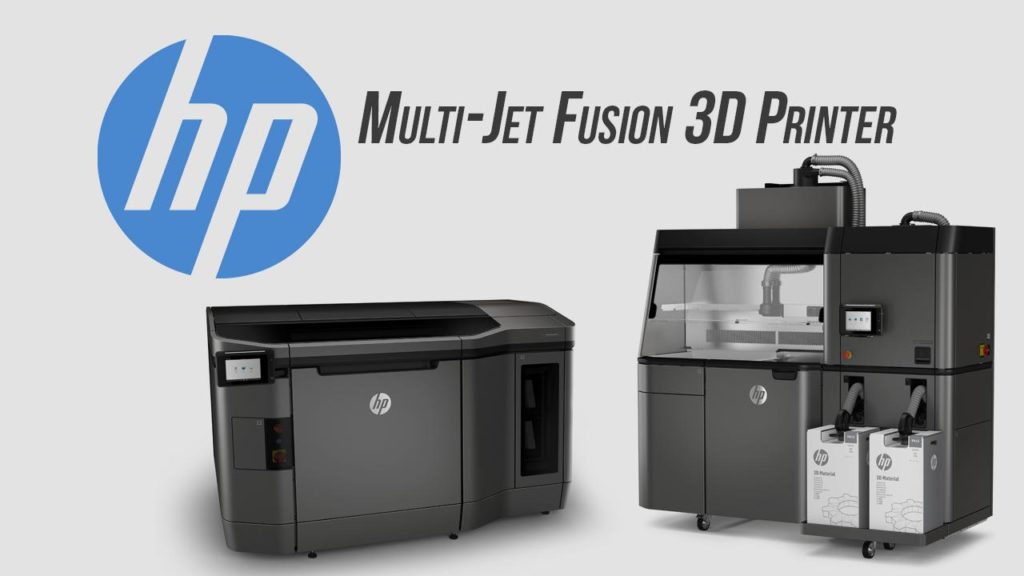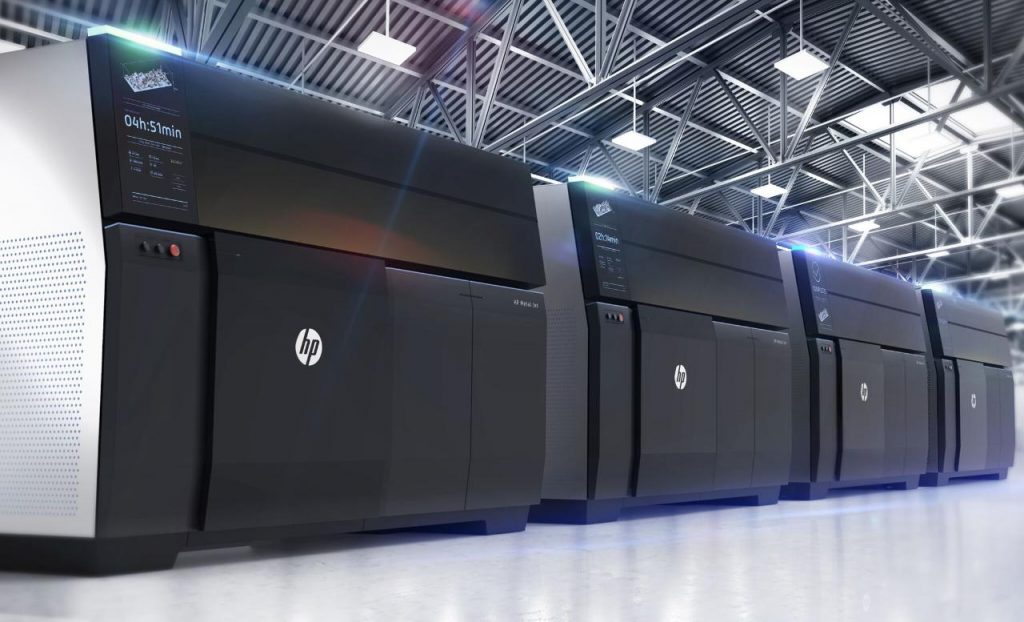BMW Opens €15 Million Additive Manufacturing Campus
BMW Group has opened its new Additive Manufacturing Campus, which combines 3D printing for research, prototyping and series parts production in a single facility. The €15 million investment is meant to further the vehicle giant’s position in the use of additive manufacturing (AM) for the automotive industry.
At the ribbon-cutting ceremony, Milan Nedeljković, BMW AG Board Member for Production, said, “Additive manufacturing is already an integral part of our worldwide production system today, and established in our digitalisation strategy. In the future, new technologies of this kind will shorten production times even further and allow us to benefit even more fully from the potential of toolless manufacturing.”
In 2019, BMW Group 3D printed roughly 300,000 parts. The Additive Manufacturing Campus employs 80 workers running about 50 industrial AM systems, including metals and plastics. Beyond the center, BMW runs 50 other 3D printers globally.
Within the site, there is a “pre-development” team that is dedicated to improving new technologies and materials for use throughout BMW, with a focus on automating process chains. By reducing manual labor, the unit aims to reduce the cost of 3D printing and make it better suited for industrial scale.
An example of the BMW Group’s work in this area is the Industrialisation and Digitisation of Additive Manufacturing for Automotive Series Production (IDAM) project, funded in part by the German Ministry of Education and Research. With the IDAM project, a production line, from production preparation to manufacturing and reworking of parts, is being established at the Additive Manufacturing Campus. The IDAM team will use the production line to create 50,000 series parts annually with 3D printing, including more than 10,000 individual and spare components.
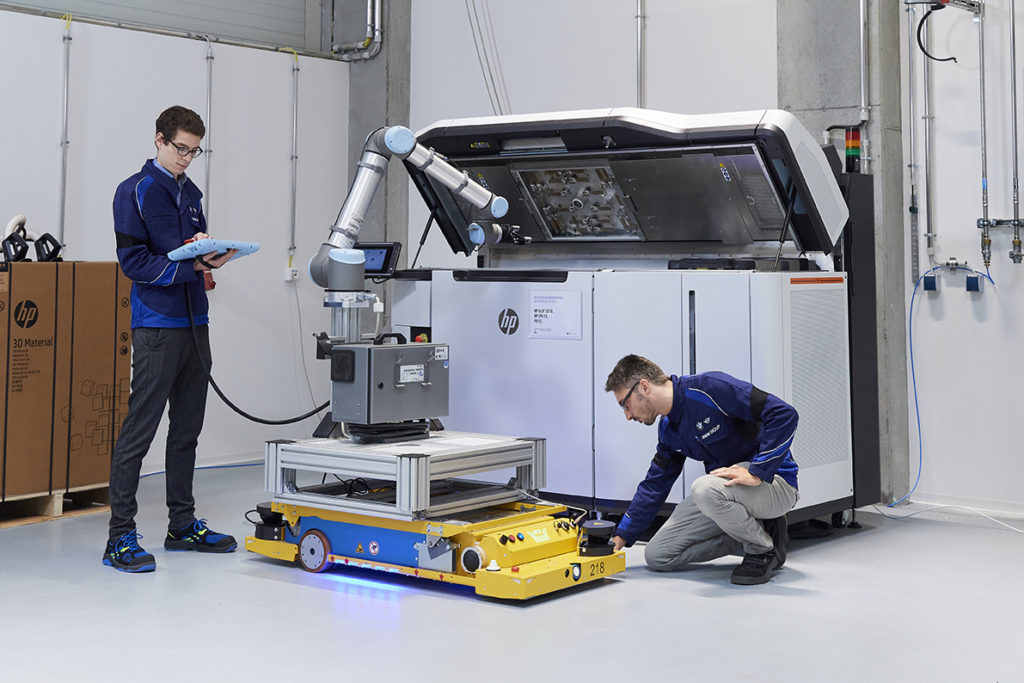
Demonstrating automation work at BMW, this image shows the use of a robotic arm with an HP Multi Jet Fusion system.
Also at the campus, BMW will be performing its work in the POLYLINE project, in which process steps for the series production of plastic parts are connected digitally and a quality assurance strategy is developed to ensure consistent quality throughout the process chain. The 15 members of the POLYLINE consortium will use the facility to create and test what they consider a “future-proof” automated production line for 3D printing plastic parts that is digitally linked. So far, the project members suggest that, through this work, manufacturing costs can be cut by 50 percent, while improving the stability of 3D printing and sustainability of production overall.

The Campus will also provide consulting and training courses for workers throughout the BMW Group as a means of successfully rolling out the various AM technologies and methodologies.
BMW has been involved in 3D printing for nearly 30 years, first prototyping parts for concept cars in 1991 before using AM for small series production in 2010. Namely, metal powder bed fusion was used to 3D print water pump wheels for DTM race cars. Since then, the company has 3D printed parts for the Rolls-Royce Phantom, BMW i8 Roadster and MINI John Cooper Works GP, a vehicle that features four 3D-printed components standard.
In addition to part production, the corporation has been investing in new AM technologies via its venture capital arm, BMW i Ventures. In 2016, the division funded Carbon’s Digital Light Synthesis for continuous digital light processing. The next year, it contributed to Desktop Metal, which has since released metal binder jetting, bound metal deposition and carbon fiber 3D printing systems.
Other investments have gone to digital manufacturing platform Xometry and German startup ELISE, dedicated to automating product design. The company can purportedly save up to 90 percent in design time by producing part “DNA” that encompasses such information as technical and load requirements, as well as manufacturing restrictions, optimization parameters and costs. The DNA can be used to then automatically create optimized parts.
All of this is directed toward BMW’s larger goals for AM and automation, which Daniel Schäfer, Senior Vice President for Production Integration and Pilot Plant at the BMW Group, spoke to: “Our goal is to industrialise 3D printing methods more and more for automotive production, and to implement new automation concepts in the process chain. This will allow us to streamline component manufacturing for series production and speed up development. At the same time, we are collaborating with vehicle development, component production, purchasing and the supplier network, as well as various other areas of the company to systematically integrate the technology and utilise it effectively.”
As described here, BMW has demonstrated expert use of the technology, just as one would expect. When it comes to series production, so far 3D printing has been limited to luxury and sports vehicles. Given its experience and expertise, however, it seems relatively safe to assume that it will be among those pushing series production of AM to more mainstream product lines. By reducing costs through the projects described above and by adopting newer technologies designed for large batch production, we may ultimately see 3D-printed end parts make it into products that the average consumer might interact with.
[Images/Source: BMW Group.]
The post BMW Opens €15 Million Additive Manufacturing Campus appeared first on 3DPrint.com | The Voice of 3D Printing / Additive Manufacturing.
POLYLINE Project: Developing Digital Production Line for 3D Printing Spare & Series Automotive Parts
Because 3D printing can ensure complex structures and geometry, mass production of individualized products seems closer than ever. But, since standards are somewhat lacking across process chains, and automated levels of handling and transport processes are low, it’s only possible to achieve horizontal and vertical AM integration in production lines on a limited basis. Additional obstacles include limited monitoring and a lack of transparency across the process chain, due to a non-continuous digital data chain at lots of interfaces. But the potential benefits of integrating AM into assembly and series production lines in the automotive industry are great, which is why the POLYLINE project was launched.
 With 10.7 Mio. Euro in funding by the German Federal Ministry of Education and Research (BMBF), this “lighthouse project” is bringing together 15 industrial, science, and research partners from across Germany with the shared goal of creating a digital production line for 3D printed spare and series automotive parts.
With 10.7 Mio. Euro in funding by the German Federal Ministry of Education and Research (BMBF), this “lighthouse project” is bringing together 15 industrial, science, and research partners from across Germany with the shared goal of creating a digital production line for 3D printed spare and series automotive parts.
The three-year project officially began at a kick-off meeting of the consortium partners this spring at the Krailling headquarters of industrial 3D printing provider EOS, which is leading the project. The other 14 partners are:
- The BMW Group,
- Grenzebach Maschinenbau GmbH,
- 3YOURMIND,
- Additive Marking GmbH,
- DyeMansion GmbH,
- Bernd Olschner GmbH,
- Optris,
- Krumm-tec,
- Paderborn University,
- Fraunhofer IGCV,
- Fraunhofer IML,
- TU Dortmund University,
- University of Augsburg, and
- University of Duisburg-Essen
BMBF is funding POLYLINE as part of the “Photonics Research Germany – Light with a Future” program in order to set up AM as a solid alternative for series production. The resulting next-generation digital production line will 3D print plastic automotive parts in an aim to complement more traditional production techniques, like casting and machining, with high-throughput systems.
The project is looking to disrupt the digital and physical production line system, and is using an interesting approach to do so that, according to a press release, “takes a holistic view and implements all required processes.” To succeed, all of the quality criteria and central characteristic values from the CAD model to the printed part need to be recorded and documented, and individual production sub-processes, like the selective laser sintering, cooling, and post-processing, will be automated and added to the production line. For the first time, all technological elements of the SLS production chain will be linked as a result.
Per the application partner’s requirements, the production line will be realized with “a high degree of maturity,” and uses cases for POLYLINE will include large amounts of both serial and customized components.
Each partner will add its own contribution to the POLYLINE project. Beginning with the leader, the EOS P 500 system will have real-time monitoring and automated loading of exchange frames added to its features; the printer will also be embedded in an automatic powder handling system. Premium automotive manufacturer the BMW Group, already familiar with 3D printing, has a massive production network of 31 plants in 15 countries, and is creating a catalog of requirements for the project to make sure that the new line will meet automotive industry standards. Additionally, the demonstrator line will be set up near its Additive Manufacturing Campus, and cause-and-effect relationships will be jointly researched.
Industrial process automation specialist Grenzebach will be responsible for material flow and transport between AM processes, as well as helping to develop automated hardware and software interfaces for these processes. 3YOURMIND is setting up a data-driven operating model, which will include “qualified digital parts inventories, orders processing, jobs and post-processing planning and execution, material management, and quality control,” while software solutions developer Additive Marking is focusing on quality management optimization and resource efficiency.
Post-processing specialist DyeMansion will develop a process for certified, UV-stable automotive colors, create Industry 4.0-ready solutions for cleaning and mechanical surface treatment with its PolyShot Surfacing (PSS) process, and contribute its Print-to-Product platform’s MES connectivity. Bernd Olschner GmbH will offer its customer-specific industrial cleaning solutions, Optris will make fast pyrometers and special thermal imaging cameras adapted for plastic SLS 3D printing, and air filter systems manufacturer Krumm-tec will work to upgrade the manual object unpacking process.
Along with other project partners, Paderborn University is “working on the horizontal process chain for the integration of additive manufacturing in a line process,” while the Fraunhofer Institute for Casting, Composite and Processing-Technology IGCV is developing a concept for POLYLINE production planning and control, which will be tested in a simulation study for scalability. The Fraunhofer Institute for Material Flow and Logistics IML will work on “the physical concatenation of process steps,” paying specific attention to flexibly linking the former manual upstream and downstream AM processes.
TU Dortmund University will help apply deep learning, and implicit geometric modeling, for data preparation and analysis, along with online monitoring and quality management, in order to achieve sustainable automation and efficiency for the project. The University of Augsburg’s Chair of Digital Manufacturing works to integrate AM processes into current production methods, and will apply its expertise in this area to the POLYLINE project, helping to develop strong vertical process chains. Finally, the University of Duisburg-Essen will focus on creating quality assurance for the material system, and its laser sintering process.
Discuss this and other 3D printing topics at 3DPrintBoard.com or share your thoughts in the Facebook comments below.
The post POLYLINE Project: Developing Digital Production Line for 3D Printing Spare & Series Automotive Parts appeared first on 3DPrint.com | The Voice of 3D Printing / Additive Manufacturing.
15 industrial and academic partners come together for “breakthrough” POLYLINE project
Twikit Showcases Mass Customized Braces and Automotive Parts at Rapid 2019
Belgian mass customization software company Twikit showcased a number of mass customization cases and applications at RAPID + TCT 2019. The Twikit team was able to show BMW Group’s Mini customized products, customized motorcycle parts and unique braces.
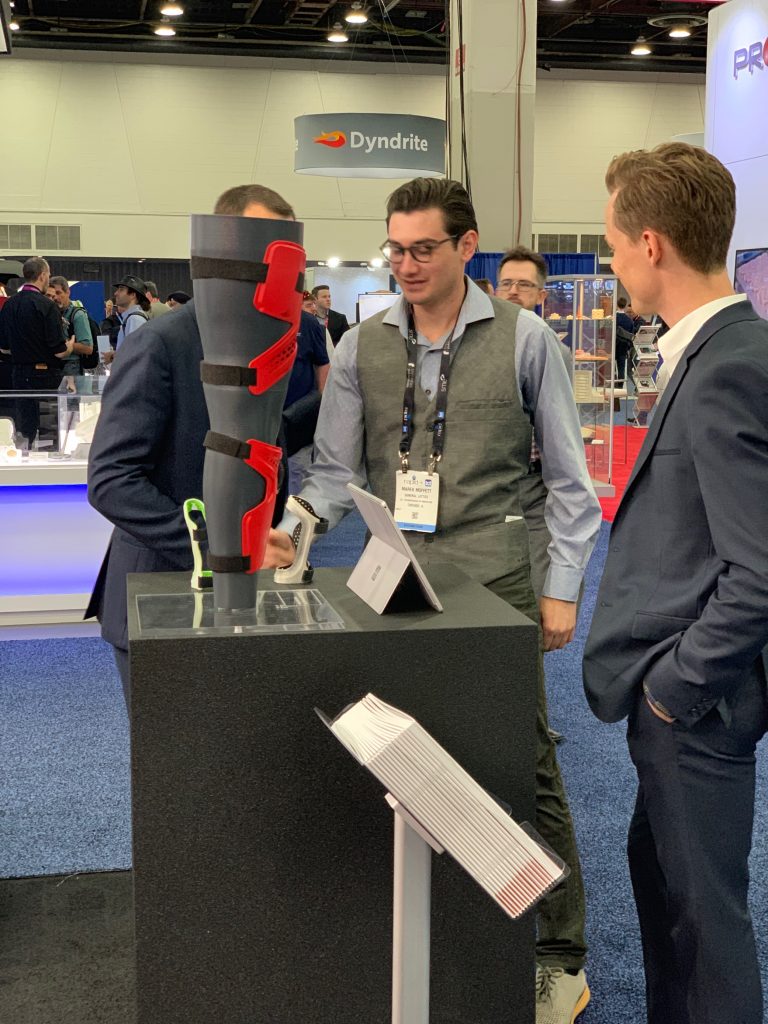
Twikit is really the only firm that has specialized individualization software that can readily mass customize unique parts for 3D printing. Whereas you could go to other firms to build custom digital supply chains to tie into your 3D printing workflow or you could cobble together half a dozen software tools to do the same in an improvised way Twikit’s is a dedicated tool. It was built from the ground up to enable the rapid parametrization of new geometries that could then made with 3D printing. Mass customization is usually a wonderful subject for conferences but most corporates shy away from actually implementing the technology. Too complex, ruffling the feathers of the supply chain and manufacturing guys and a perception that it would be hard to implement scare companies off. Whereas I’m usually very skeptical of startups I’m very optimistic about Twikit’s prospects and their tooling. The company has spent a long time pioneering deep in the darkest woods and the world has finally caught up with it.
The BMW mass customization case is, of course, the one that caught all the headlines. Thanks to Twikit Mini owners can now use an online tool to mass customize decorative items on their cars. The software connects with BMW’s internal workflow and existing management software to give a traceable manufacturable solution to the German luxury auto giant.
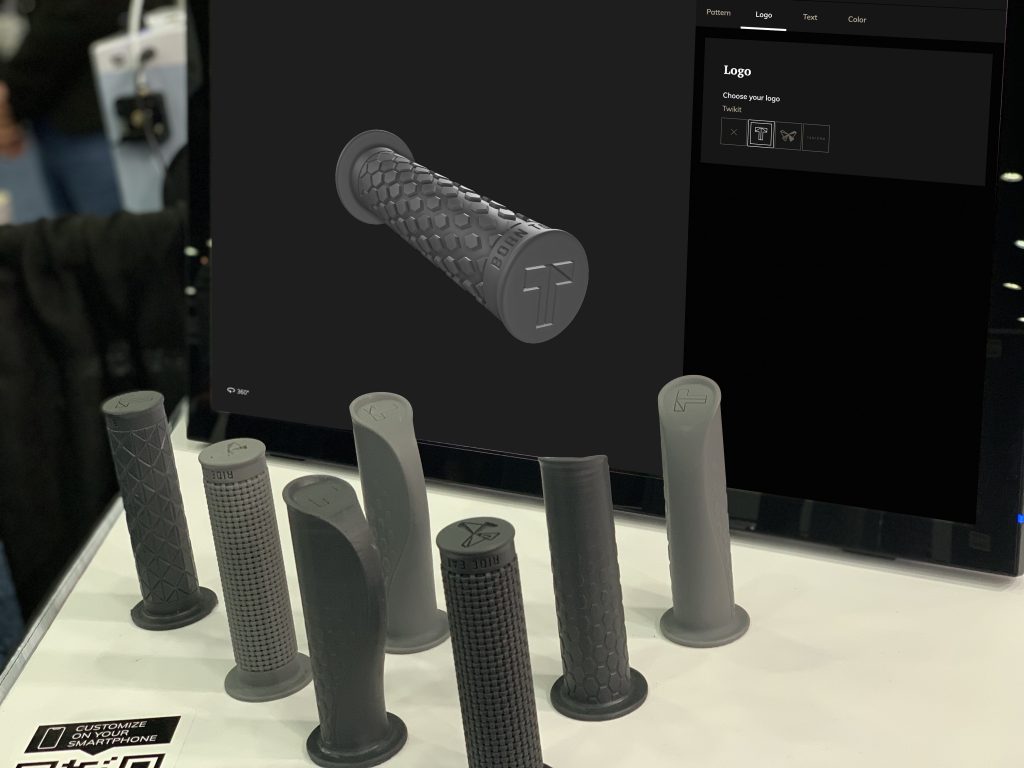
Twikit also worked together with OEM Formlabs to create customized motorcycle handles for startup Tarform. The handlebar is a central element in your control, contact with and experience with the motorcycle. I’ve personally long believed that handles for tennis rackets, golf clubs, steering wheels and all manner of things are a huge applications so I love this implementation.
“In the Twikit software platform, the customer can make his desired adjustments until he’s satisfied with the final design. This customization experience can be experienced on both smartphone and desktop. The desired and final product is saved as a 3D file and will be exported within the cloud to an stl. file which will be sent afterward to Formlabs’ 3D printer. To become the final product, Formlabs makes use of flexible resin, which allows bendable/compressible parts to be printed. Now the actual production process can be set in motion.”
I love the idea that through 3D printing you could achieve better ergonomics, or perhaps have a more comfortable ride or better control over the bike. The user’s increased satisfaction with the bike because they designed part of it will also help. You can see a video here of the process.
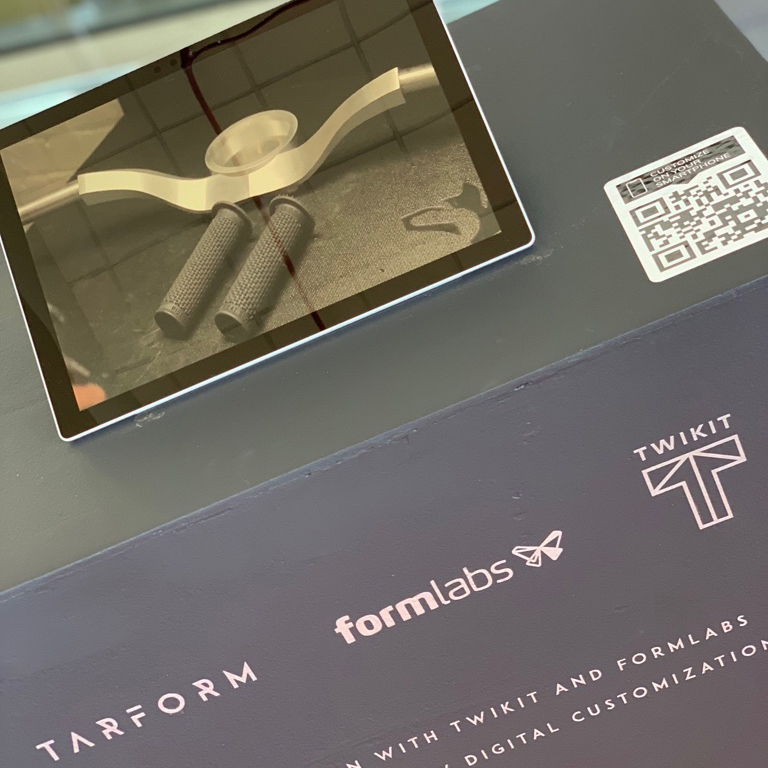
The application with the most far-reaching implications, however, was one where Twikit’s software was used to make customized braces. Through Twikit 3D scan data could be turned into a unique orthotic or prosthetic. Here the software was used to obtain a precise comfortable fit to the human body. In applications such as postoperative braces, braces and across the spectrum in orthotics and prosthetics, the need for something like this is huge. Twikit has created a key bit of technology that can really accelerate the adoption of mass customization and 3D printing. With the right partners this could be pushed out to millions of parts worldwide.
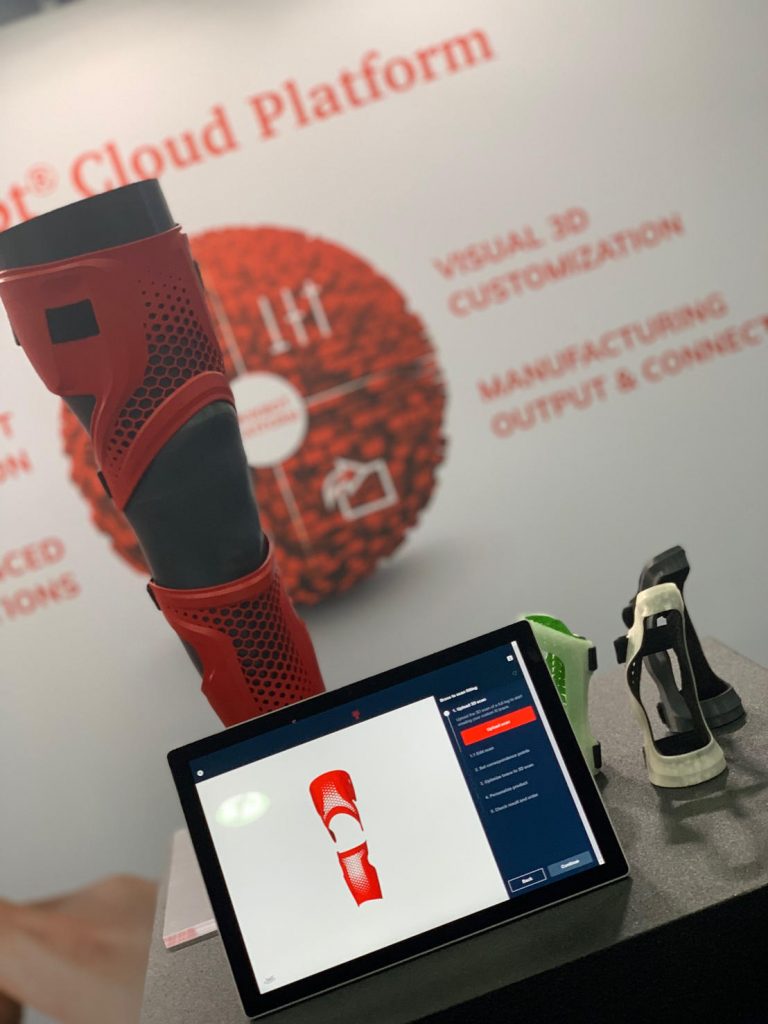
Big Push in Germany to Enable 3D Printing in Automotive Industry
3D printing and additive manufacturing have become a matter of national importance in Germany, and to the automotive industry overall. Several organizations—along with the ongoing support of the Fraunhofer Institute for Laser Technology ILT and the Chair for Digital Additive Production DAP of RWTH Aachen University—are eager to see the Industrialization and Digitization of Additive Manufacturing for Automotive Series Processes (IDAM) lead the way for furthering the use of AM processes in the auto industry. Project partners for IDAM include a variety of small to medium enterprises (SMEs) and research institutions, all dedicated to the progress of metallic 3D printing for the manufacturing of vehicles.
BMW Group is behind much of this push, and their dedication to additive manufacturing for almost 30 years has not gone unnoticed. From an investment in a new AM facility in Munich to specialized projects like restoring Elvis’ long-lost BMW 507 from 1958, their work in 3D printing has been so prolific that by last year they had fabricated over one million parts, harnessing the untold power of this progressive technology. Currently, 3D printing and AM processes with metal are in force at BMW’s facility in Munich, along with GKN Powder Metallurgy’s factory in Bonn.
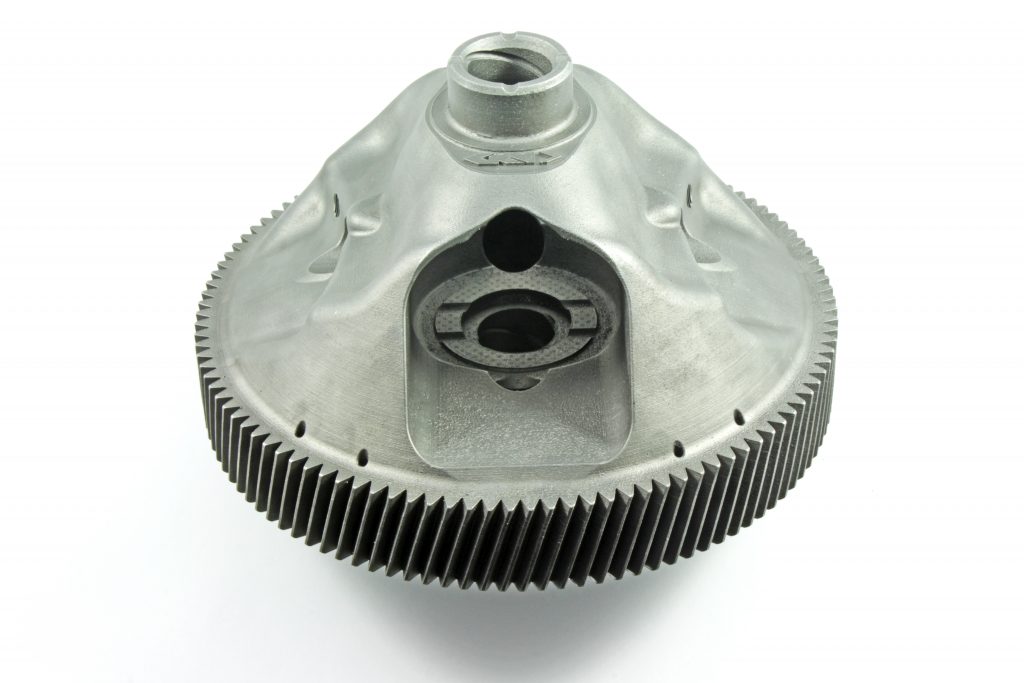
This structural optimized differential housing, jointly developed by GKN Powder Metallurgy and Porsche Engineering, is one of the growing new e-drive powertrain applications for Metal AM (Photo: GKN Powder Metallurgy)
There are 12 partners total working within the ongoing project via IDAM, and as Fraunhofer Institute for Laser Technology ILT points out in their latest press release, the use of metallic 3D printing should ‘sustainably strengthen Germany’s technological pioneering role and the country itself as a manufacturing location.’ Everyone involved is obviously envisioning making use of all of 3D printing’s most famed benefits, beginning with greater affordability. Along with that comes exponential reduction of turnaround time in manufacturing, and the ability to offer a wide range of customization options for clientele.
The IDAM team is present at both facilities, qualifying the technology for production of metal parts, with projections for manufacturing at least 50,000 3D printed parts annually. They also expect over 10,000 individual and spare parts to be created. This is a far cry from the initial use of 3D printing for low-batch production of customized parts. Even with plans for mass production, the partners expect high-performance parts to be created ‘under extreme cost pressure.’
Project partners include:
- Aconity GmbH, Herzogenrath
- Concept Reply GmbH, Munich
- Fraunhofer Institute for Laser Technology ILT, Aachen
- GKN Powder Metallurgy, Radevormwald
- Myrenne GmbH, Roetgen
- Intec GmbH – Ingenieurbüro für Automatisierungstechnik, Bad Neuenahr-Ahrweiler
- Kinexon Industries GmbH, Munich
- Chair for Digital Additive Production DAP, RWTH Aachen, Aachen
- Technical University of Munich, Chair of Metal Forming and Casting, Munich
- Schmitz Spezialmaschinenbau GmbH, Rheinbreitbach
- Volkmann GmbH, Soest
This activity truly marks the beginning of metal AM taking a prioritized role within Germany’s industrial dynamic, with two modular production lines being installed (one in Munich; one in Bonn). Customization is key here too, as modules can be changed to fit production needs.
“In addition, their process steps can be controlled and utilized flexibly,” states Fraunhofer Institute for Laser Technology ILT in their press release. “By taking an integrated view of the automotive production line into account, the project partners plan on reducing the manual share of activities along the process chain from currently around 35 percent to less than 5 percent. In addition, the unit costs of 3D printed metal components should be more than halved.”
The IDAM partners are currently using their experience and expertise in designing modules for the mass production line, to include automated processes for powder handling, monitoring, post-processing, and more.
“Since large industrial companies are involved, these linked modules can be used in the AM production lines under real conditions and on a large scale,” explains the Fraunhofer Institute for Laser Technology ILT release. “In addition, industrial standards can be set, and industry-relevant quality characteristics elaborated. Only through this interdisciplinary cooperation does the IDAM project make it possible to holistically examine metallic 3D printing for automotive series processes and to establish it sustainably in production.”
What do you think of this news? Let us know your thoughts! Join the discussion of this and other 3D printing topics at 3DPrintBoard.com.
BMW unveils Individual M850i Night Sky with 3D printed meteoric parts
BMBF project creates novel concepts for metal 3D printing in automotive production
BMW Surpasses One Million 3D Printed Automotive Components
BMW Group has been using 3D printing for more than 25 years, and in the last decade has produced a million parts using the technology. This year alone, the company expects that it will 3D print more than 200,000 components, a 42 percent increase over last year. And BMW Group is just getting started. The company is aggressively pursuing additive manufacturing, intent on staying ahead in an automotive industry that is rapidly embracing the technology.
“The use of components made by additive manufacturing in series production of vehicles is increasing particularly strongly at the moment,” said Dr. Jens Ertel, Director of the BMW Group Additive Manufacturing Center. “We are following the development and application of advanced these manufacturing methods very closely indeed, partly through longstanding cooperations with leading manufacturers in the field. At the same time, we are engaging in targeted technology scouting and evaluating innovative production systems.”
BMW Group’s millionth 3D printed component came recently in the form of a 3D printed window guide rail for the BMW i8 Roadster. It took only five days to develop and was quickly integrated into series production. The guide rail, which is located in the door of the Roadster, allows the window to operate smoothly. It was manufactured using HP’s Multi Jet Fusion technology, which is now being used in the series production of automobiles for the first time. The technology is capable of producing up to 100 window guide rails in 24 hours. Additionally, BMW uses EOS Selective Laser Sintering and various other technologies for metal and polymers.
The window guide rail isn’t the only 3D printed component in the BMW i8 Roadster – it wasn’t even the first, actually. The first was the fixture for the soft top attachment, which was 3D printed from aluminum alloy. It is both lighter and stiffer than the traditional injection molded plastic component used in its place. This year, the component won an Altair Enlighten Award in the Modules category.
BMW Group began using both plastic and metal back in 2010 for the production of a smaller series of components such as the water pump pulley for DTM vehicles. In 2012, the company began using laser sintering for several components for the Rolls-Royce Phantom. While many automotive companies are using 3D printing in their manufacturing processes, a lot of them are mainly using the technology for tooling purposes. BMW Group has been one of the pioneers in using 3D printing for actual functional car parts.
 The company has big plans for 3D printing in the future. Recently it began offering several customization options for the BMW MINI, many of them 3D printed. Last year BMW Group began using 3D printing for the fiber optic guides in the Rolls-Royce Dawn; Rolls-Royce currently has 10 3D printed components in its product line.
The company has big plans for 3D printing in the future. Recently it began offering several customization options for the BMW MINI, many of them 3D printed. Last year BMW Group began using 3D printing for the fiber optic guides in the Rolls-Royce Dawn; Rolls-Royce currently has 10 3D printed components in its product line.
It was just earlier this year that BMW Group built a new dedicated Additive Manufacturing Campus, which likely at least partially accounts for the drastic increase in 3D printed parts over the last year. The two 3D printed components in the BMW i8 Roadster were designed and produced at the Additive Manufacturing Center, among many others. BMW Group has long been a leader in 3D printing in the automotive industry, and it clearly intends to hold on to that designation.
Discuss this and other 3D printing topics at 3DPrintBoard.com or share your thoughts below.
[Source: Automobile Magazine]
HP’s Multi Jet Fusion and Metal Jet 3D Printing Technology Continue to Accelerate
As formnext kicks off in Frankfurt, Germany, several companies are already making big announcements. HP is no exception, blazing into formnext with a series of updates regarding its Jet Fusion 3D printing technology.
“HP is accelerating the shift to 3D mass production, enabling an exciting array of applications helping customers improve their businesses as we enter the 4thIndustrial Revolution. Many industries such as automotive, which is going through its biggest transformation in more than 100 years, are looking to new technologies and strategic partners like HP to help them better compete in this time of change,” said Christoph Schell, President of 3D Printing and Digital Manufacturing, HP Inc. “We are working with innovators across the globe to change the way they design and manufacture with HP Multi Jet Fusion and our new Metal Jet platform, unlocking new applications, more manufacturing flexibility, and greater innovation, efficiency and sustainability across their product development lifecycle.”
Part of HP’s news involves the continuing worldwide expansion of its technology with the addition of some new customers. RecTech 3D is based in China and will be using Multi Jet Fusion technology as it expands into a full-fledged industrial Additive Manufacturing Center in Chongqing. Working with HP, the company plans to offer application and design expertise as well as training to customers and partners. In early 2019, RecTech 3D will begin installing 10 HP Jet Fusion 3D 4210 printers in its Additive Manufacturing Center, with plans to grow to 30 machines by the end of the year.
“As a premier partner of HP in China, RecTech 3D is looking to help lead industrial innovators and designers to take advantage of digital production and manufacturing, and we believe HP Multi Jet Fusion technology offers the capabilities required to deliver on that promise,” said Jay Luo, CEO, RecTech 3D. “In addition to offering the production of parts using HP Multi Jet Fusion technology, we will provide our customers with educational resources and end-to-end solutions based on HP’s industry-leading 3D printing products and expertise that enable the entire process from design to production. Using HP Multi Jet Fusion technology we plan to transform manufacturing.”
 Meanwhile, US-based Forecast 3D is growing steadily with the installation of 24 HP Jet Fusion 3D 4210 in its digital factory. In addition, GE Transportation will use HP’s Jet Fusion solutions in its John F. Welch Technology Center in Bangalore, India to produce industrial parts for applications in mining vehicles and locomotives.
Meanwhile, US-based Forecast 3D is growing steadily with the installation of 24 HP Jet Fusion 3D 4210 in its digital factory. In addition, GE Transportation will use HP’s Jet Fusion solutions in its John F. Welch Technology Center in Bangalore, India to produce industrial parts for applications in mining vehicles and locomotives.
“Our business continues to reap the rewards of leaning in early and going big with HP Multi Jet Fusion technology,” said Corey Weber, CEO, Forecast 3D. “Our 3D Manufacturing Center is now powered by 24 HP Jet Fusion 3D 4210 printers. We are serving more customers than ever, running 24×7, and on pace to surpass millions of Multi Jet Fusion parts produced this year.”
In the automotive industry, BMW Group is using HP Jet Fusion 3D 4200 printers to manufacture the window guide rail for the BMW i8 Roadster, while Volkswagen Group is using HP systems for both metal and plastic. By the end of the year, 100 percent of the tools used to manufacture the new T-Cross SUV will be 3D printed using Multi Jet Fusion technology. In addition, Volkswagen will begin to use HP’s Metal Jet 3D printing technology starting with mass-customizable parts such as key rings and name plates.
“Using our automotive standards and HP’s Multi Jet Fusion technology our manufacturing team is able to produce durable, reliable final parts such as the window guide rail for our BMW i8 Roadster,” said Dr. Dominik Rietzel, Head of Non-Metal Additive Manufacturing at the BMW Group. “In the past decade, we are proud to have produced more than one million 3D printed parts, and it’s fitting that one of these window guide rails was identified as the one-millionth part printed. Complex parts that require reliable functionality and a small footprint are a perfect example of the power of additive manufacturing and together with partners such as HP we are excited about the possibilities ahead.”
HP recently introduced the new PA-11 material, which has seen a great deal of use already. Its properties include strength, ductility, impact resistance and enhanced elongation break. Bowman International used the material to produce a rollertrain cage, while orthotic company OT4 used it to create a sleep helmet. Other parts produced with PA-11 include shoe heels by New Rock and personalized phone cases by Freshfiber.
HP’s Jet Fusion 3D 300/500 series is a lower-cost version of its MJF technology, and early customers include A-Dec, a dental equipment manufacturer using the technology to produce fixtures, jigs and low-volume service parts; Rady Children’s Hospital, which is using it to create casts, corrective devices, and anatomical models; and the University of Louisville, which is using the technology in numerous applications across several departments.
HP is now offering new online resources for partners and customers who are looking to accelerate their adoption of 3D printing for mass production. These include the i-AMdigital Talent Platform, a digital career growth platform for additive manufacturing, and 3D ExchangeNet, a marketplace dedicated to helping 3D printing businesses identify growth capital, investment or buyout opportunities.
At formnext, HP will be showcasing its recently introduced Metal Jet technology, which, according to the company, can offer up to 50 times more productivity at lower cost than competitors. Companies using the technology already include Volkswagen, GKN Powder Metallurgy, Parmatech, Wilo, Primo Medical Group and OKAY Industries. In the first half of 2019, customers will be able to order Metal Jet parts through the new Metal Jet Production Service.
Formnext is taking place from today until November 16th. You can visit HP at Booth E40 in Hall 3.1.
Discuss this and other 3D printing topics at 3DPrintBoard.com or share your thoughts below.

